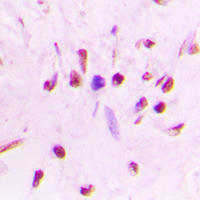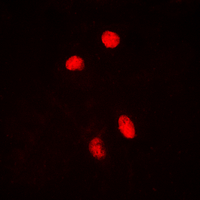产品描述:Rabbit polyclonal antibody to HSF1 (Phospho-S303)免疫原:KLH-conjugated synthetic phosphopeptide corresponding to residues surrounding S303 of human HSF1 protein. The exact sequence is proprietary.纯化方式:The antibody was purified by immunogen affinity chromatography.克隆类型:Polyclonal产品形式:Liquid in 0.42% Potassium phosphate, 0.87% Sodium chloride, pH 7.3, 30% glycerol, and 0.01% sodium azide.稀释比:WB (1/500 - 1/1000), IH (1/100 - 1/200), IF/IC (1/100 - 1/500)基因名称:HSF1相关名称:HSTF1; Heat shock factor protein 1; HSF 1; Heat shock transcription factor 1; HSTF 1
基因编号(人):
3297;
蛋白编号(人):
Q00613;
储存效期:Shipped at 4°C. Upon delivery aliquot and store at -20°C for one year. Avoid freeze/thaw cycles.
-
 Western blot analysis of HSF1 (Phospho-S303) expression in HEK293T (A) whole cell lysates. (Predicted band size: 57 kD; Observed band size: 82 kD)
Western blot analysis of HSF1 (Phospho-S303) expression in HEK293T (A) whole cell lysates. (Predicted band size: 57 kD; Observed band size: 82 kD) -
 Immunohistochemical analysis of HSF1 (Phospho-S303) staining in human lung cancer formalin fixed paraffin embedded tissue section. The section was pre-treated using heat mediated antigen retrieval with sodium citrate buffer (pH 6.0). The section was then incubated with the antibody at room temperature and detected using an HRP conjugated compact polymer system. DAB was used as the chromogen. The section was then counterstained with haematoxylin and mounted with DPX.
Immunohistochemical analysis of HSF1 (Phospho-S303) staining in human lung cancer formalin fixed paraffin embedded tissue section. The section was pre-treated using heat mediated antigen retrieval with sodium citrate buffer (pH 6.0). The section was then incubated with the antibody at room temperature and detected using an HRP conjugated compact polymer system. DAB was used as the chromogen. The section was then counterstained with haematoxylin and mounted with DPX. -
 Immunofluorescent analysis of HSF1 (Phospho-S303) staining in HepG2 cells. Formalin-fixed cells were permeabilized with 0.1% Triton X-100 in TBS for 5-10 minutes and blocked with 3% BSA-PBS for 30 minutes at room temperature. Cells were probed with the primary antibody in 3% BSA-PBS and incubated overnight at 4 °C in a hidified chamber. Cells were washed with PBST and incubated with a DyLight 594-conjugated secondary antibody (red) in PBS at room temperature in the dark.
Immunofluorescent analysis of HSF1 (Phospho-S303) staining in HepG2 cells. Formalin-fixed cells were permeabilized with 0.1% Triton X-100 in TBS for 5-10 minutes and blocked with 3% BSA-PBS for 30 minutes at room temperature. Cells were probed with the primary antibody in 3% BSA-PBS and incubated overnight at 4 °C in a hidified chamber. Cells were washed with PBST and incubated with a DyLight 594-conjugated secondary antibody (red) in PBS at room temperature in the dark.
Deciphering human heat shock transcription factor 1 regulation via post-translational modification in yeast
The master regulator of the cellular stress response (HSF1) is critical for orthopoxvirus infection
HSF1 regulation of ß-catenin in mammary cancer cells through control of HuR/elavL1 expression


 说明书
说明书 MSDS
MSDS